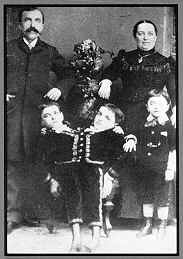|
|
SIAMESE TWINS
In her compelling history of freak museums,
Andrea Dennett notes that "in general, five classes of human anomalies
were displayed in dime museums: natural [congenital] freaks; . . . self-made
freaks [e.g., the "tattooed man,"]; . . . non-Western freaks [usually
foreign persons exploited because of their exotic 'otherness']; . . .
and fake freaks [who feigned congenital mutation]" (66). Of these classifications,
the 'natural freaks' and the 'non-Western freaks' appear especially significant
for our analyses.
Make Your
Own Celebrity Freak
|
 |
Perhaps the most famous of all congenital freaks
to be displayed in America were the prototypical 'Siamese Twins,' Chang and
Eng, who originally hailed from Siam (Thailand). If one adopts Dennett's rubric,
they were both natural and non-Western freaks, which made them particularly
freakish in the eyes of a public willing to pay to see them. The physical and
metaphysical implications of conjoined twins have created consternation throughout
history: in seventeenth century Europe, the Italian conjoined twin Lazarus-Johannes
presented theological conundrums of great import for a civilization still trying
to come to terms with the repercussions of the Reformation: did they possess
one soul or two? (Pender 144). The two-as-one body (similar in some ways to
the hermaphroditic one), inevitably evokes a sense of transgressive sexuality,
both in its creation (through unsplit ovum/ova) and in its daily physiology.
Sexual privacy necessarily dissolves in the shared world of conjoined twins.
The whole point of freak shows is to capitalize on publicizing the private.
Married to sisters, Chang-Eng's bodies reminded viewers of the twins' yoked
sexuality: "the sexuality of either man, because witnessed-and thus to some
extent participated in-by the other, represented prospects transgressive to
the Victorian American culture in which they lived: homosexuality (because both
were male), incest (because they were brothers), and adultery (because each
would, in a sense, be sleeping with a woman not his wife" (Pingell 105-106).
Thus the private practices of the twins came under public scrutiny. They toured
with their wives and children, and their Family Book, wherein was written the
names of their 22 children, "presents an ambiguity about who really fathered
whom" (111). The freak(s), once again, challenge(s) the conventional views of
'family' and sexual propriety, ultimately calling into question, through their
very existence as two individuals without single agency, the ideal of American
independence.

